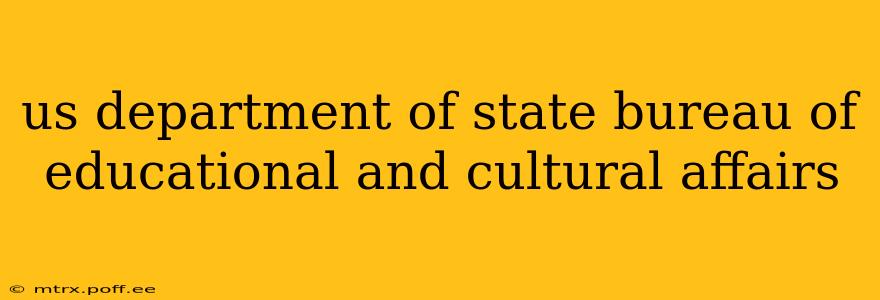The Bureau of Educational and Cultural Affairs (ECA) within the U.S. Department of State plays a vital role in shaping America's image abroad and promoting mutual understanding between the United States and other nations. It achieves this through a diverse range of exchange programs that connect people from all walks of life, fostering collaboration and strengthening international ties. This comprehensive guide will delve into the ECA's mission, programs, and impact on global diplomacy.
What is the Bureau of Educational and Cultural Affairs (ECA)?
The ECA is a fascinating agency dedicated to building bridges between cultures. It designs and implements international exchange programs that promote mutual respect and understanding. These programs aren't just about sightseeing; they aim to build lasting relationships between individuals and institutions, influencing policy and creating a more interconnected world. The bureau works tirelessly to showcase American culture and values while simultaneously learning from and engaging with other cultures. This reciprocal exchange is at the heart of its mission.
What programs does the Bureau of Educational and Cultural Affairs offer?
The ECA administers a wide array of impactful programs, each designed to achieve specific diplomatic goals. These programs are diverse, catering to various demographics and professional fields. Some notable examples include:
-
Fulbright Program: Arguably the most well-known, the Fulbright Program offers scholarships and grants for graduate students, scholars, artists, and professionals to study, conduct research, or teach abroad. It fosters intellectual collaboration and builds lasting networks between American and international scholars.
-
International Visitor Leadership Program (IVLP): This program brings prominent international leaders to the United States for short-term exchanges, exposing them to American society, institutions, and values. It aims to build relationships with future leaders and influencers.
-
EducationUSA: This network of advising centers provides information and guidance to students who wish to study in the United States. It assists international students throughout the application process and promotes American higher education institutions globally.
-
American Film Showcase: This program utilizes the power of film to connect with audiences internationally, fostering dialogue and cross-cultural understanding. It showcases American films and facilitates discussions around relevant themes.
These are just a few examples; the ECA’s portfolio is incredibly broad and constantly evolving to meet the demands of a changing global landscape. The programs are carefully curated to maximize their impact on international relations.
What are the goals of the Bureau of Educational and Cultural Affairs?
The ECA's overarching goal is to promote mutual understanding and cooperation between the United States and other countries. This involves:
-
Strengthening U.S. diplomacy: The programs foster positive relationships with key international partners, promoting cooperation on shared challenges.
-
Sharing American culture and values: The ECA showcases the diversity and dynamism of American society, countering negative stereotypes and misconceptions.
-
Promoting educational opportunities: The exchange programs enhance educational opportunities for both Americans and citizens of other nations.
-
Building networks: The bureau cultivates strong relationships between individuals, institutions, and organizations across the globe.
-
Responding to global challenges: ECA initiatives often address crucial issues such as climate change, public health, and economic development, providing a platform for collaborative solutions.
How does the Bureau of Educational and Cultural Affairs impact U.S. foreign policy?
The ECA's work is deeply intertwined with U.S. foreign policy. By fostering understanding and cooperation, the bureau helps pave the way for stronger diplomatic ties. The long-term relationships developed through these programs often translate into stronger collaborations on crucial global issues. The ECA's soft power approach complements traditional diplomatic efforts, creating a more robust and nuanced foreign policy strategy.
How can I get involved with the Bureau of Educational and Cultural Affairs?
There are various ways to engage with the ECA, depending on your background and interests. You can:
-
Apply for a program: If you’re a student, scholar, artist, or professional, consider applying for one of the many exchange programs offered.
-
Support the ECA: You can advocate for increased funding for these important programs, which have a significant impact on global diplomacy.
-
Follow their work: Stay informed about the ECA's activities and programs through their website and social media channels.
The U.S. Department of State's Bureau of Educational and Cultural Affairs is a critical component of American foreign policy, using cultural exchange as a powerful tool for diplomacy and international understanding. Its work is vital in fostering a more interconnected and peaceful world.
